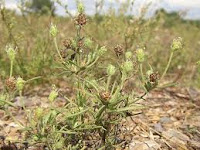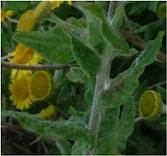This plant is native to Europe , North Africa and both temperate and tropical Asia . In the past it was used in traditional medicine for dysentery, hence the name fluxweed. It is sometimes called mustard tansy, (Not Tansy) although there is another plant with this name, Descurainia pinnata, a close relative.
Fluxweed is in the Brassicaceae or Cruciferae family which makes it a relative of the Savoy
In German the herb is known as Sophienkraut the herb of Saint Sophia who was invoked in past times to prevent late frosts occurring by people who had arable crops such as rye, barley and oats.
The ancient herbalists called this plant “Sophia chirurgerum” the ‘wisdom of surgeons’, showing how highly esteemed it was. It was renowned for its wound healing properties in the past.
It was also considered to be effective for sore and ulcerated throats, when equal parts of the juice of fluxweed and honey and vinegar were mixed and taken as a gargle.
 The whole plant has been used as a poultice for toothache, and the flowers and leaves have astringent properties, which is why it is good for dysentery and wound healing. The seed is considered to be a cardio-tonic, demulcent (soothing the mucous membranes) a diuretic, expectorant used for coughs, a laxative and tonic, as well as being able to reduce fevers. The seeds are sometimes used in a poultice, ground, and put on burns scalds and sores.
The whole plant has been used as a poultice for toothache, and the flowers and leaves have astringent properties, which is why it is good for dysentery and wound healing. The seed is considered to be a cardio-tonic, demulcent (soothing the mucous membranes) a diuretic, expectorant used for coughs, a laxative and tonic, as well as being able to reduce fevers. The seeds are sometimes used in a poultice, ground, and put on burns scalds and sores. Writing in the 17th century, the English herbalist Nicholas Culpeper has this to say of it:-
 “Government and virtues. This herb is saturnine also. Both the herb and seed of Flux-weed is of excellent use to stay the flux or lask of the belly, being drank in water wherein gads of steel heated have been often quenched; and is no less effectual for the same purpose than Plantain or Comfrey, and to restrain any other flux of blood in man or woman, as also to consoladate bones broken or out of joint. The juice thereof drank in wine, or the decoction of the herb drank, doth kill the worms in the stomach or belly, or the worms that grow in putrid and filthy ulcers, and made into a salve doth quickly heal all old sores, how foul or malignant soever they be. The distilled water of the herb works the same effect, although somewhat weaker, yet it is a fair medicine, and more acceptable to be taken. It is called Flux-weed because it cures the flux, and for its uniting broken bones, &c.. It is uniting broken bones, &c. Paracelsus &c extol it to the skies. It is fitting that syrup, ointment, and plaisters of it were kept in your house.”
“Government and virtues. This herb is saturnine also. Both the herb and seed of Flux-weed is of excellent use to stay the flux or lask of the belly, being drank in water wherein gads of steel heated have been often quenched; and is no less effectual for the same purpose than Plantain or Comfrey, and to restrain any other flux of blood in man or woman, as also to consoladate bones broken or out of joint. The juice thereof drank in wine, or the decoction of the herb drank, doth kill the worms in the stomach or belly, or the worms that grow in putrid and filthy ulcers, and made into a salve doth quickly heal all old sores, how foul or malignant soever they be. The distilled water of the herb works the same effect, although somewhat weaker, yet it is a fair medicine, and more acceptable to be taken. It is called Flux-weed because it cures the flux, and for its uniting broken bones, &c.. It is uniting broken bones, &c. Paracelsus &c extol it to the skies. It is fitting that syrup, ointment, and plaisters of it were kept in your house.” In clinical trials it has been found to have analgesic (mild pain-killing) properties plus antioxidant, antipyretic, antimicrobial and anti-inflammatory ones. One or two studies claim that it has some anticancer properties too and inhibits the growth of cancerous cells. It also has insect repellant properties and repels in particular, mosquitoes and sand flies.
In clinical trials it has been found to have analgesic (mild pain-killing) properties plus antioxidant, antipyretic, antimicrobial and anti-inflammatory ones. One or two studies claim that it has some anticancer properties too and inhibits the growth of cancerous cells. It also has insect repellant properties and repels in particular, mosquitoes and sand flies. Fluxweed is cultivated in Afghanistan and China and used for digestive problems, so it’s a very versatile herb.


















































